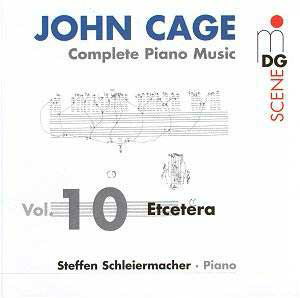It seemed to me a little strange that an older woman should
busy herself with sticks and strike the piano. So I said to Grete
[Sultan] that I would write a couple of pieces for her... (John
Cage)
The result of this was Etudes Australes
completed in 1976 and playing for over three hours!
Etudes Australes, in four books of eight
études each, is thus a large-scale, ambitious and – no doubt
– demanding achievement. Cage based the cycle on star charts of the
Southern Hemisphere, hence the title. (There also exists another set
titled Etudes Boréales.) He placed transparent
paper over the charts and elaborated them according to certain operations
derived from various sources such as the I-Ching. From this,
Cage and Grete Sultan worked out the chords that can be played within
the range of a ninth (i.e. for Sultan’s hands). The Etudes
form a process of densification: an increasing number of chords
appear from piece to piece, and single tones become rarer and rarer.
(I owe these and other explanations to Schleiermacher’s excellent and
detailed notes.) Formally, the set of Etudes Australes
is designed as a duet for two independent hands; and, as a result, two
staves are assigned to each hand. Pitches are fully notated, but without
any durations or dynamics. No tempo is prescribed though Cage nevertheless
requires a uniform tempo for each piece. The score also indicates some
proportional distances, and a clear difference is made between open
note heads and closed note heads : "open notes" are to be
held until just the second following note in the same hand, whereas
"closed notes" are to be played briefly. Thus, the player
has to make a number of decisions before ever playing a single note,
according to a number of parameters and to the level of density or complexity
of each étude. As Schleiermacher rightly observes, "it is
tempting to play the somewhat less concentrated pieces at a fast tempo
and to play the complicated ones at a very slow tempo." The player
may also choose to play the whole set fortissimo throughout so
that it eventually sounds as a gigantic monolith. He may also prefer
a more varied approach to each piece.
Considering all this, it is clear that Etudes
Australes allows for some considerable freedom on the player’s
part. The set is also fiendishly difficult and demanding, sometimes
on the verge of unplayability, and taxing the player’s physical strength
and resistance, as well as (and most importantly, I think) the player’s
re-creative imagination. Steffen Schleiermacher, who is also a composer,
clearly possesses all these qualities, and his dedicated readings are
obviously carefully prepared and fully committed. His remarkable qualities
are never in doubt, though I for one could not help but feel a certain
monotony, probably partly due to his deliberate choice of dynamics.
This release, though, will undoubtedly appeal to all Cage fans who will
warmly welcome this new recording of one of Cage’s most ambitious and
important works.
Hubert Culot


